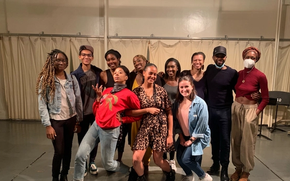

A Conversation on ‘Contentious Woman’
Meet the Participants

Sahmaya Busby (she/her/hers) is the 2022 Artistic & Literary Intern at PlayCo. She is a rising sophomore majoring in Drama & Theatre Arts and Political Science at Columbia University. She is also a member of BWOG, a student journalism organization at Columbia, and Orchesis.
On July 21, I interviewed Celeste Jennings and Stevie Walker-Webb, the respective playwright and director of Contentious Woman, a developmental reading PlayCo produced as part of the Studio program. It was a hybrid interview––with Jennings joining me at PlayCo’s office and Walker-Webb joining me virtually for a conversation that centered around the artists’ experience with the play.
I read Contentious Woman early into my time as PlayCo’s 2022 Artistic & Literary intern, and I was fascinated by the poetic writing and the inclusion of music as part of storytelling–and I was thrilled to virtually attend the reading, directed by Walker-Webb. The play features five Black women who work in an exploitative tobacco factory in Edwardian Durham, North Carolina. I immediately felt drawn to Jennings’ vivid, raw writing and careful attention to the fluidity of time. Jennings’ writing was brought to life at the reading through the brilliant portrayals by actors Ameerah Briggs (Hazelhurst), Alex Elam (Paris), Bobbi Johnson (Red), and Erin Pettigrew (Bethesda), and Brennie Tellu (Monroe), and Walker-Webb’s direction.
We began the conversation by learning more about Walker-Webb’s journey as an artist, which began with writing and directing a play that responded to the forced removal of low-income housing development residents by a private university in his Texas hometown. Walker-Webb now serves on the board for the theater he founded but continued his theatre journey in New York City. Currently, he is set to make his Broadway debut in the fall, directing Jordan E. Cooper’s Ain’t No Mo’.
Soon after, Jennings arrived at the PlayCo office, exuding warmth and smiles and greeting me with a hug. After Jennings’ arrival and greetings, we began with one of the key things that struck me about Contentious Woman–the formulation of the five wholly dynamic characters. “I’ve wanted to write about Black women in this kind of Edwardian time period from 1912 to 1919,” Jennings said. “But I didn’t know what it was going to be about for a really long time. Last year, I went to Durham to visit a friend for a few days and we went to visit what used to be a plantation and now it’s like ecotourism-except-plantation. I don’t know what you call that–history tourism? Or something else probably that’s not very nice…but I learned a little bit about all the tobacco factories and the deep history that’s rooted in Durham, and I thought I would try to set this play during that time period.”
I was also interested in how Walker-Webb added his artistic take on the characters; Walker-Webb chose not to infuse his characterizations into Celeste’s writing. “There’s so much flesh and blood on the page that there was–for me as a man–a kind of respect immediately that I needed to enter that space. Like when I’m alone in my room and I’m reading these voices, their presence is there, which is such a testament to Celeste.”
To Jennings: “You wrote these women that are flesh and blood before I even add to it. Celeste is deceptively powerful. Don’t let the smooth taste fool you. She’s such a powerful woman. For me, my approach for this was different from any other approach I’ve ever had as a director, which was mainly just to listen.”
Next, we discussed how Jennings’ writing process begins. What are the goals when she writes a work like Contentious Woman? How does the writing generate from those goals? And how does the director, Walker-Webb, begin his process when staging a reading and align his objectives when directing?
For Jennings, writing a play begins with poetry. She then goes on to make fragments of the story, referring to them as “bones,” which are then organized into a storytelling body. “I’m always afraid that I’m going to write the same play,” Jennings shared on her playwriting process, “I just want to have full Black women with full lives and full experiences, just like we have. Poetry is always going to be there. Contentious Woman is my most dialogue-heavy play, so I feel like I’m trying to move more into that world right now. I want to do that every single time, which is why I’m always afraid when I’m beginning to write.
Jennings paraphrased a quote from a book Walker-Webb gifted her, Alice Walker’s The World Has Changed. “‘When you write a new thing, it always feels like the first time,’ so I was like, ‘Yes! Okay, good, it’s not just me.’ That makes me feel a lot better. I guess it gives me a little bit of confidence to just kind of let go of that and like if I write the same thing, that’s just that,” she laughs. “And I’ll just do something else after that.”
In response, Walker-Webb quoted author James Baldwin: “‘Every writer has only one story to tell. And he or she has to find a way of telling it until the meaning becomes clearer and clearer until the story becomes at once more narrow and larger, more and more precise, more and more reverberating.’”
Walker-Webb illustrated an analogy of how he views his directorial projects: “Ain’t No Mo is like this rocket child who grew up really fast, and now I can’t say anything to it…and then I have other ‘children’ that walk into my life like Contentious Woman, which feels like a child that was born into the world who was already fifty…I don’t need to educate it. I don’t need to go in and move the architecture around, but I need to help the world look at it…I feel like my job is to help birth the vision of the playwright.”
Walker-Webb said that his Contentious Woman directorial process began with reading the script out loud and going for a walk to ruminate, but he describes his research as a sterile process, that includes “scrubbing underneath his nails” to experience a new play–outside of the work. For Contentious Woman, the research included reading Zora Neale Hurston and watching interviews with Nikki Giovanni and James Baldwin. For both artists, research is a holistic process that involves piecing together stories, art, and theory, to enhance their ideas before the official creation.
Lastly, I discussed with the artists what they want their audiences to extract from their work, particularly works like Contentious Woman–and whether their visions differ across audiences. Jennings responded, “ …I’m writing toward Black women–Black communities. I feel like I’m just trying to create a space from 90 to 110 minutes where we can sit in a space and feel comfortable and not have to question if we’re supposed to be there, if we deserve to be there …I just hope I can have genuine work genuinely created with heart and respect for the people involved in it–people onstage and sitting down…Shared similarities and shared experiences or feelings. Shared humanity. I hope that non-Black people can see those characters and think about their relationship to Black people, and when they leave, not look at a Black person and instantly forget that we’re not three-fifths.”
Walker-Webb’s goals lie in the effect the work has on his audiences. “I want you to feel something. I want you to feel entertained. I want you to feel uncomfortable, or I want you to feel rejected. Or I want you to feel embraced. I want you to feel irate…if you want to feel bored, I want you to feel dramatically, like laboriously bored…I want you to make you feel something. That’s my job as a director.” He also noted how his lived experience affects how he communicates his work. “When I’m directing a play. I try not to think about race when I’m directing a play, but rather think about the truth of the story. Even if it’s a hyper-Black experience…because I’m Black, everything I do is Black..as long as I don’t have to worry about policing my Blackness or performing it…I just make the most truthful thing I can make, and people can come up to the buffet line and pick off what they want.”
After the interview, I thanked Jennings and Walker-Webb for their time and we said our goodbyes. These two artists were incredibly kind and thoughtful, bringing valuable words to the table, as well as praising each other for their knowledge and artistic processes. The conversation was insightful and impelling, offering an exciting glimpse into the mindsets and processes that created the reading for Contentious Woman.
Related Productions

Written by
Sahmaya Busby